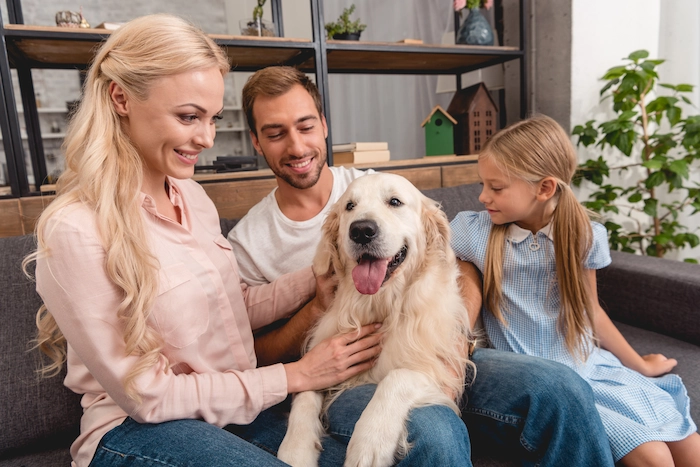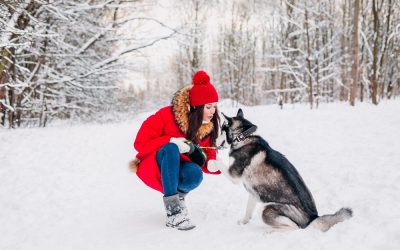There are 6.3 million adoptable animals entering shelters every year, including 3.1 million dogs. Welcoming a dog into your home through the adoption process is one of the best ways to get a new pet, and it’s a true act of love. Dog adoption transforms your life and helps reduce overcrowding in dog shelters.
This guide details everything from the adoption fee and lifestyle assessment to bringing your dog home and training it.
Overview of the Dog Adoption Process
If you’re thinking about adopting a new best friend, congratulations! Bringing a dog into your life is hugely rewarding — especially if you’re transforming a rescue dog’s life. Here’s how to get started:
- Assess your lifestyle and home environment. Consider your daily routine, living space and family members’ activity levels. For example, if you have a spacious yard, there’s room for a large dog. If you live in a cozy apartment, you’ll need a smaller pet.
- Choosing the right dog for your family. Every dog has a unique personality and needs. However, some families are better suited to dog breeds with certain temperaments. If you have small children, dogs such as golden retrievers and Labrador retrievers can be ideal. If you’re looking for a guard dog to protect your home and don’t have young children, you might opt for a cane corso or bullmastiff. It’s important to research traits so you can find a good match for your household.
- Finding a dog to adopt. Find adoptable pets at your local shelter or on online adoption platforms and rescue organizations. You can explore social media to adopt a dog, but be sure to conduct thorough research and only adopt from trustworthy places. Most shelters take care of medical issues, neuter surgery, microchipping and vaccinations before adopters take them home, making them a safe choice.
Understanding Shelter Assessments and Adoptable Dogs
Shelters typically assess dogs’ behavior, health and temperaments to match them with suitable adopters. Be sure to ask about these assessments and learn about any dogs you’re interested in, including their health, history and any special needs. Understanding what your new dog has been through gives you an idea of what you’ll spend at the veterinarian each year and how much time you’ll need to dedicate to training.
Step-by-Step Guide to Dog Adoption Application Process
Here’s a step-by-step guide to help you navigate the adoption process.
1. Filling Out the Application
Shelters and rescue organizations typically require you to complete an adoption application form. It asks questions about your lifestyle, living situation and previous pet experience as well as whether you have kids and other relevant information. This helps them match you with the puppies and dogs best suited to your home and level of experience.
2. What to Expect in the Screening Process
After you submit an application, the shelter or rescue group reviews it. They might follow up with a background check, a reference check and a home visit to make sure your living environment is suitable for pets. Adoption shelters tend to be more thorough when it comes to screening potential dog owners compared to those looking to adopt cats.
3. Meeting Potential Dogs
After you’ve been approved, the shelter introduces you to any dogs you requested to meet and those that match your requirements and living situation. Be sure to spend plenty of time interacting with each dog instead of making a choice based purely on cuteness to find the one that clicks best with you and your family.
Consider factors such as temperament, energy levels and compatibility with your lifestyle. Remember, many larger dogs require tons of exercise, so make sure you have time to meet the dog’s needs and give it the best life.
4. Questions to Ask the Shelter Staff
Shelter staff are happy to answer any questions you might have, so don’t hesitate to ask about dogs you’re interested in adopting. You might inquire about:
- Medical history
- How they get along with other pets
- Known situations that might trigger them
- Favorite toys and dog treats
- Special needs and requirements
5. Finalizing the Adoption
The last step is paying an adoption fee to cover the cost of care for the dog while it lived in the shelter, including any medical and safety protocols. Dog adoption costs enable shelters to continue caring for animals in need. There’s a good chance you’ll sign a contract, and you might need to present your identification.

Bringing Your New Pet Home
The most important thing to get right with your new dog is the first few days, which set the stage for a happy life together. Being intentional when it comes to training, socialization and how you approach introductions prepares everyone for successful, happy cohabitation.
The First Few Days: Setting Up for Success
When your dog gets home:
- Create at least one designated space for bedding, toys and water and one consistent space for food.
- Introduce your new dog to your home room by room to prevent overwhelming it.
- Stick to a routine when it comes to potty breaks, eating and exercise to help your new dog feel safe and secure.
- Set up Halo Collar, with features including GPS tracking and a wireless dog fence, to keep your new pet safe.
Introducing a New Dog to Family and Other Pets
When introducing your new pet to the family:
- Supervise all initial interactions, and gradually introduce new people and pets one at a time.
- Use positive reinforcement and treats to encourage good behavior and prevent conflicts.
- Make sure all pets have their own exclusive space to call their own and retreat to.
Training and Socializing Your New Dog
Let’s look at tips to help you train and socialize your new pet:
- Cesar Millan’s Training Method: Emphasizes calm assertiveness and understanding canine behavior, focusing on leadership and consistency
- Halo Collar for Training: Uses GPS tracking and virtual fencing to offer real-time feedback and guidance in training sessions
- Socialization: Involves gradually exposing your dog to different environments and introducing it to various people and animals to ensure it becomes a well-adjusted and confident pet
Ready to Welcome a Furever Friend?
Adopting a dog is a lifelong commitment filled with love, joy and responsibility. Here are some resources to help you navigate the process:
- American Society for the Prevention of Cruelty to Animals (ASPCA): Provides resources on pet care, behavior and adoption, as well as a searchable database of shelters and rescue groups across the United States
- The Humane Society of the United States: Offers information on pet adoption, training and behavior, along with advocacy efforts for animal welfare legislation and initiatives
- Petfinder: A widely used online database for finding adoptable pets in shelters and rescue organizations across the country, with helpful tips and resources for new pet owners
- Best Friends Animal Society: Offers adoption resources, educational materials and support for pet owners and operates animal sanctuaries and advocacy programs nationwide
Whether you’re a first-time pet owner or adding to a growing furry family, remember that adoption is a rewarding journey that enriches both your and your pet’s life.










